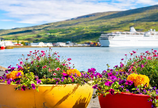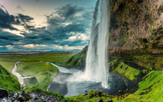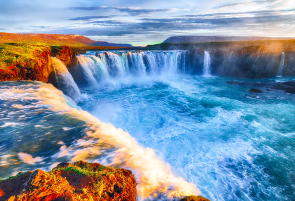Nestled between Greenland and mainland Europe, Iceland stands out as a land of contrasts and captivating beauty. Known as the Land of Fire and Ice, it’s home to a blend of fiery volcanoes, massive glaciers, and scenic landscapes that redefine natural beauty. In recent years, Iceland has become a top travel destination for adventurers and nature enthusiasts alike. This ultimate travel guide covers everything you need to know about travelling to Iceland—from its diverse landscapes to practical travel tips—to ensure a memorable journey.
Why Visit Iceland?

Iceland is more than a travel destination it’s an experience unlike any other. Its unique geography shaped by volcanic activity and glacial erosion creates surreal landscapes that seem to belong in another world Iceland offers.
- Stunning Natural Landscapes – Iceland is famous for its glaciers geysers, lava fields waterfalls and black sand beaches.
- Adventure Opportunities – Whether it’s hiking, whale-watching ice-caving or snorkelling between tectonic plates theways something thrilling to do.
- Northern Lights – Iceland is one of the best places on Earth to witness the mesmerizing aurora borealis.
- Friendly Locals – Icelanders are known for their hospitality and warmth, making the travel experience even more enjoyable.
Iceland When you will Visit?

Iceland’s climate varies greatly across seasons and each season offers its own set of attractions. Here’s a breakdown:
- Summer (June to August) – The summer months are perfect for exploring Iceland’s landscapes as you’ll experience the Midnight Sun. This season is also ideal for road trips around the country.
- Winter (November to March) – Winter is the prime season to see the Northern Lights but it’s also a great time for winter sports like ice-caving and skiing.
- Spring (April to May) and Fall (September to October) – These shoulder seasons offer milder weather fewer crowds and lower travel costs.
How to Get to Iceland

Iceland is well-connected to major cities worldwide. The main gateway is Keflavík International Airport (KEF) located about 50 kilometres from Reykjavík the capital city. Icelandair and WOW Air offer many direct flights to Keflavík from North America and Europe.
Once you arrive, you can take a shuttle bus, taxi or car rental to get to Reykjavík. If you plan to explore the countryside, renting a car is highly recommended for flexibility.
Essential Iceland Travel Tips
- Weather Preparation – Iceland’s weather can be unpredictable. It’s best to pack layers and prepare for both rain and shine on any given day.
- Currency – The Icelandic Króna (ISK) is the local currency but credit cards are widely accepted.
- Language – While Icelandic is the official language almost everyone speaks English, especially in tourist areas.
- Wi-Fi and Connectivity – Iceland has excellent internet coverage with free Wi-Fi available at most public places.
- Stay Safe – Iceland is one of the safest countries in the world, but nature can be unpredictable. Observe safety precautions when visiting isolated locations.
Top Destinations and Attractions in Iceland
- Reykjavík – The Vibrant Capital
Reykjavík Iceland’s capital is a blend of modern culture and rich history. Here are some must-visit places:
- Hallgrímskirkja: This famous church provides sweeping city vistas.
- Harpa Concert Hall – A stunning piece of architecture and home to concerts and events.
- Sun Voyager – A striking sculpture along the waterfront symbolizing Iceland’s Viking heritage.
- The Golden Circle – A Scenic Route of Wonders
The Golden Circle is a popular tourist route covering three of Iceland’s most famous landmarks:

- The meeting point- of the North American and Eurasian tectonic plates is Þingvellir National Park a UNESCO World Heritage Site.
- Geysir Hot Springs – Home to erupting geysers, with Strokkur being the most popular.
- Gullfoss Waterfall – A breathtaking two-tiered waterfall that showcases Iceland’s powerful natural forces.
- Glaciers and Black Sand Beaches on the South Coast
The South Coast offers some of Iceland’s most iconic scenery:
- Seljalandsfoss – A stunning waterfall you can walk behind for unique views.
- Reynisfjara Black Sand Beach – A surreal landscape with basalt columns and sea stacks.
- Jökulsárlón Glacier Lagoon – Known for its floating icebergs and home to seals and Arctic wildlife.
- Vatnajökull National Park – Home to Iceland’s Largest Glacier
Vatnajökull is the largest glacier in Europe and its namesake park is the ideal spot for glacier hiking ice-caving and exploring vast landscapes. Svartifoss Waterfall, framed by dark basalt columns is one of the highlights here.
The Westfjords – Off-the-Beaten-Path Adventures
The Westfjords offer an escape from the typical tourist routes. Here you’ll find:
- Dynjandi Waterfall – One of Iceland’s most beautiful waterfalls cascading in a series of steps.
- Hornstrandir Nature Reserve – A remote area with no roads perfect for hiking and birdwatching.
- Látrabjarg Cliffs – Home to thousands of puffins especially during the summer months.
- The Highlands – Rugged and Remote Landscapes
Iceland’s highlands are only accessible during the summer months and they’re known for their rugged beauty and volcanic landscapes. Landmannalaugar is popular for its rainbow-coloured mountains and Askja Caldera offers a unique volcanic landscape.
- Northern Lights – Iceland’s Winter Wonder
One of the top reasons people visit Iceland in winter is to witness the Northern Lights. To increase your chances of seeing the aurora borealis, visit between September and March head to dark areas away from city lights and keep an eye on the aurora forecast.
Adventure Activities in Iceland

- Glacier Hiking and Ice-Caving
Iceland’s glaciers offer some of the most unique hiking experiences in the world. Popular locations are Iceland’s Vat and Sólheimajökull, where both novice and expert hikers may take guided trips.
- Snorkeling and Diving
At Silfra in Þingvellir National Park, you can snorkel between the Eurasian and North American tectonic plates. This clear-water experience is considered one of the best diving spots globally.
- Whale Watching
From April to October, you can see various whale species including humpback whales blue whales and orcas. Iceland’s whale-watching capital is Húsavík in North Iceland.
- Horseback Riding
Icelandic horses are a unique breed known for their strength and unique gait the tolt. Riding through the countryside on one of these beautiful horses is a memorable way to explore Iceland.
- Lava Tubing and Volcano Tours
With its volcanic terrain, Iceland offers opportunities for exploring lava tubes—natural tunnels formed by flowing lava. Raufarhólshellir is one of the most accessible lava tubes.
Iceland’s Hot Springs and Geothermal Pools

Iceland’s volcanic activity has resulted in a number of geothermal pools and hot springs. The Blue Lagoon is perhaps the most famous offering a luxurious experience with spa facilities and a surreal
blue hue. But for a more genuine experience think about going to:
- Mývatn Nature Baths – Located in North Iceland with views of the surrounding volcanic landscape.
- Secret Lagoon – Iceland’s oldest natural pool located in Fluor.
- Reykjadalur Hot Spring River – A scenic hiking trail leading to a naturally warm river.
- Icelandic Cuisine – Must-Try Dishes The natural resources of the island are fundamental to Icelandic cuisine. Some local dishes to try include:
- Lamb Soup (Kjötsúpa) – A hearty dish made with Icelandic lamb and vegetables.
- Skyr – A traditional dairy product similar to yoghurt often enjoyed with berries or honey.
- Plokkfiskur – A fish stew made from boiled fish potatoes and onions.
- Icelandic Hot Dog (Pylsur) – A unique blend of pork beef and lamb served with mustard ketchup and fried onions.
Where to Stay in Iceland

Iceland has a range of accommodation options from budget-friendly hostels to luxury hotels. Here are some popular choices:
- Reykjavík – Ideal for city lovers with options ranging from budget hostels to luxury hotels.
- Vik – A small village on the South Coast perfect for exploring nearby black sand beaches and waterfalls.
- Akureyri – Known as the capital of North Iceland offering easy access to nearby attractions like Myvatn Lake.
Getting Around Iceland
Iceland’s road network is excellent but the best way to explore the country is by renting a car. Here are some options.
- Ring Road (Route 1) – The main highway that circles the island providing access to many popular destinations.
- Public Transport – Limited to city buses in Reykjavik with a few long-distance routes.
- Guided Tours – A popular option for those who prefer to sit back and relax while seeing the sights.
Environmental Responsibility – Leave No Trace

Iceland’s natural beauty is delicate and preserving it for future generations is essential. It is advised that visitors abide by the Leave No Trace guidelines.
- Stick to marked paths to prevent erosion.
- Avoid picking plants or disturbing wildlife.
- Pack out all waste including biodegradable items.
Final Thoughts
Iceland’s nickname as the Land of Fire and Ice is well-deserved with its unique geography and breathtaking beauty. Whether you’re captivated by glacier hikes mesmerized by the Northern Lights or fascinated by Iceland’s volcanic wonders there’s something for everyone in this stunning destination.
From geothermal pools to towering waterfalls, Iceland offers endless opportunities for adventure and relaxation alike. Following this travel guide, you’ll be well-prepared to explore this magical land and make memories that will last a lifetime.
Embark on your journey to Iceland and discover why this unique island is a top travel destination worldwide
